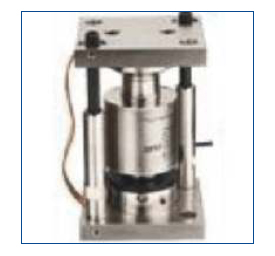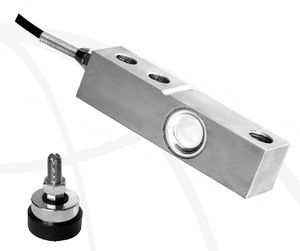Load Cells
Load Cell is used to convert a force into electrical signal. This conversion is indirect and happens in two stages. Through a mechanical arrangement, the force being sensed deforms a strain gauge. The strain gauge measures the deformation (strain) as an electrical signal, because the strain changes the effective electrical resistance of the wire. A load cell usually consists of four strain gauges in a Wheatstone bridge configuration. Load cells of one strain gauge (quarter bridge) or two strain gauges (half bridge) are also available. The electrical signal output is typically in the order of a few millivolts and requires amplification by an instrumentation amplifier before it can be used. The output of the transducer can be scaled to calculate the force applied to the transducer.
Types
Hydraulic Load Cell
The piston is placed in a thin elastic diaphragm. The piston doesn't actually come in contact with the load cell. Mechanical stops are placed to prevent over strain of the diaphragm when the loads exceed certain limit. The load cell is completely filled with oil. When the load is applied on the piston, the movement of the pistonand the diaphragm arrangement result in an increase of oil pressure which in turn produces a change in the pressure on a bourdon tube connected with the load cells
Pneumatic Load Cells
The load cell is designed to automatically regulate the balancing pressure. Air pressure is applied to one end of the diaphragm and it escapes through the nozzle placed at the bottom of the load cell. A pressure gauge is attached with the load cell to measure the pressure incide the cell. The deflection of the diaphragm affects the airflow through the nozzle as well as the pressure inside the chamber.
Strain Gauge Load Cells
These are the most common, there are other types of load cells as well. In industrial applications, hydraulic is probably the second most common, and these are utilized to eliminate some problems with strain gauge load cell devices. As an example, a hydraulic load cell is immune to transient voltages so might be a more effective device in outdoor environments.
Others
Other types include Piezoelectric Load Cells , and Vibrating Wire Load Cells, which are useful in geomechanical applications due to low amounts of drift, and capacitive load cells where the capacitance of a capacitor changes as the load preses the two plates of a capacitor closer together. Every load cell is subject to ringing when subjected to abrupt load changes. This stems from the spring-like behavior of load cells. In order to measure the loads, they have to deform. As such, a load cell of finite stiffness must have spring-like behavior, exhibiting vibrations at its natural frequency. An oscillating data pattern can be the result of ringing. Ringing can be suppressed in a limited fashion by passive means. Alternatively, a control system can use an actuator to actively damp out the ringing of a load cell. This method offers better performance at a cost of significant increase in complexity. Load cells are used in several types of measuring instruments such as universal testing machines.
Features
- Standard dimension for easy mounting.
- Insensitive to vibrations.
- Unique mounting arrangements.

